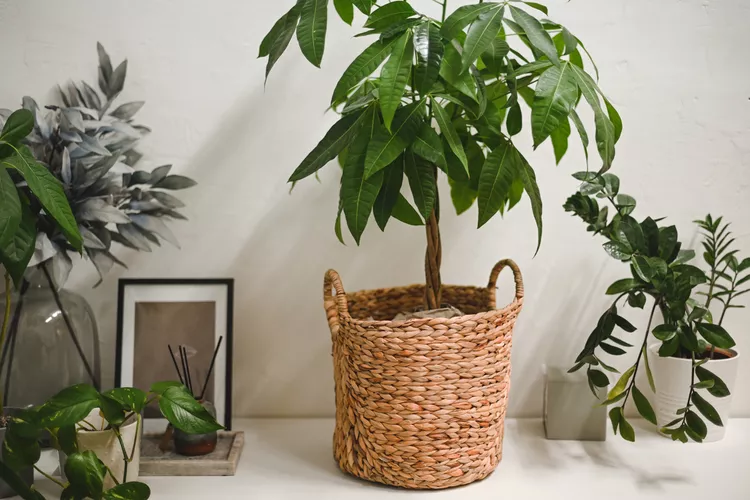Sporting distinctive leaves and sometimes a braided trunk, money trees are popular houseplants that are said to bring good fortune. Money trees sold as houseplants are one of two species: Pachira aquatica or Pachira glabra. Both of these plants look similar when grown indoors in pots (their differences are more obvious when they flower and fruit in their native habitats in Central and South America). This guide will help you to grow and care for a money tree as a houseplant, and maybe you'll enjoy a little financial luck of your own.
Money Tree Overview
| Genus Name | Pachira |
| Common Name | Money Tree |
| Additional Common Names | Money Plant, Water Chestnut |
| Plant Type | Houseplant, Tree |
| Light | Part Sun |
| Height | 6 to 8 feet |
| Width | 2 to 3 feet |
| Foliage Color | Blue/Green |
| Zones | 10, 11 |
Money Tree Care Tips
Money trees adapt well to a range of indoor conditions. Keep them looking their best with these guidelines.
Light
Grow a money tree in medium to bright indirect light.
Soil and Water
Use a general purpose potting mix that drains well. Water your indoor money tree every 1–2 weeks, allowing the potting mix to dry out a little between waterings to avoid overwatering and root rot.
Temperature and Humidity
Indoor temperature should not dip below 65°F. Money trees can tolerate typical indoor humidity levels but also benefit from increased humidity. To increase humidity levels around your plant, use a humidifier, set up a pebble tray, and/or group plants with similar care requirements together.
Pruning
Money trees don't need frequent pruning. The only pruning your plant may require is removing dead or dying stems and leaves.
Potting and Repotting
Money tree houseplants are easy to repot following these steps:
- Remove the plant from its current pot by turning your plant sideways, and tapping the bottom of the pot until the plant's root ball loosens enough to slide the entire thing out. You might need to give it a bit of help with a couple of gentle tugs on the base of the stems.
- Loosen the plant’s roots gently with your fingers. Prune off any threadlike roots that are extra-long, but leave the thicker roots at the base of the foliage. If your plant is root bound (the roots are growing in very tight circles around the base of the plant) untangle the roots as best you can and give them a trim.
- Remove at least one-third or more of the old potting mix surrounding the plant's roots. As it grew, your plant removed some or all of the nutrients in the current mix, so you'll want to give it fresh potting mix.
- Pour a layer of fresh potting soil into the new planter and lightly press it down.
- Set your plant on top of the fresh mix in the planter, making sure it's centered.
- Add more potting mix around the plant's roots until your money tree sits securely in its new pot.
- Water well, allowing the excess to drain out the bottom of the pot.
A freshly repotted money tree does not need additional fertilizer if the potting mix already includes some. Otherwise, provide liquid fertilizer once a month when you water.
Pests and Problems
If you see money tree leaves turning yellow, it's often a sign of overwatering. Curling leaves is a sign of underwatering. Leaves falling off often indicates your plant isn't getting enough light.
Many common houseplant pests such as scale, spider mites, and mealybugs will attack money trees. A strong spray of water can help reduce populations, but for severe infestations, use neem oil or insecticidal soap to get rid of the pests.
How to Propagate Money Trees
Money trees are best propagated by cuttings rooted in soil by following these basic steps:
- With clean pruners, cut off a healthy section of stem that has multiple nodes towards the bottom of the cutting. These nodes are where new roots will begin.
- Dip the bottom of the cutting in rooting hormone
- Stick the stem into fresh pre-moistened potting mix.
- Firm the mix down around the base of the stem to secure the cutting in place.
- Water well, allowing the excess to drain
- Set your potted money tree cutting in a warm spot, with indirect light, and water when dry.




















